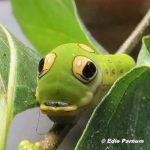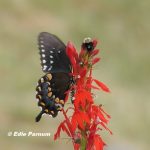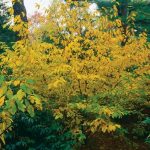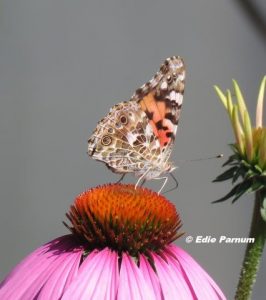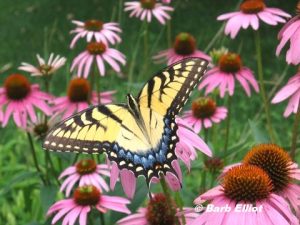By Edie Parnum
Every year we feature two superior native plant species. One of the Prime Plants for Nature is a Tree, Shrub, or Vine and the other is a Perennial. Prime Plants are selected based on these criteria:
- Native to southeastern Pennsylvania.
- Offer high wildlife value and contribute significantly to your property’s web of life.
- Provide food for wildlife by producing nutritious fruits, seeds, nuts, nectar, or pollen. Most host insects that are eaten by birds or other animals.
- Offer shelter and places to raise young.
- Easy to grow and make an attractive addition to your landscape.
- Sold at native plant nurseries and native plant sales.
Our selections for the 2018 Prime Plants for Nature awards are:
Northern Spicebush, Lindera benzoin
Wildlife Value: In the fall this shrub produces high-lipid red berries that are valuable formigrating birds including Gray Catbird, American Robin, Hermit Thrush, and other thrushes. The foliage of Spicebush is food for the
Spicebush Swallowtail Butterfly caterpillar. In fact, this caterpillar species is entirely dependent on Spicebush and its close relative, Sassafras, for its sustenance. Spicebush is also a host plant for Eastern Tiger Swallowtail and Promethea Moth. The flowers are pollinated by small native bees, wasps, beetles, and flies.
Growing Conditions: This fast-growing, disease-free shrub will thrive in a variety conditions from semi-sun to shade in average to moist soil. Its natural habitat is the understory of moist woodlands or woodland edge. The leaves, twigs, and other plant parts are spicy when crushed, so deer don’t usually browse this shrub.
Appearance: The Spicebush is a multi-stemmed 6-12’ deciduous shrub. Its blossoms appear in early spring before the foliage emerges. Although the flowers are small, they create a nice show of yellow haze when little else is blooming. Because this shrub is dioecious, male and female flowers occur on separate plants, and the berries form from female flowers. The fall foliage is yellow.
Purple Coneflower, Echinacea purpurea
Wildlife Value: Purple Coneflower’s pollen and nectar are magnets for many bees and butterflies. Bumble bees and short and long-tongued bees such as small carpenter, sweat, long-horned, digger, and mining bees plus long-horned beetles visit the flowers. Butterflies such as swallowtails, sulphurs, fritillaries, Red Admiral, American and Painted Ladies, Monarch, and skippers are attracted also. Crab spiders may lurk in the flowerheads to capture both beneficial and pest insects. A few moth caterpillars will eat the flowers and leaves including Blackberry Looper, Camouflaged Looper (adorns itself
with flower parts to avoid predators), Common Pug, and Sunflower Moth. In late summer and fall the coneflowers’ seeds are eaten by American Goldfinch and other finches.
Cultivars of Purple Coneflower are frequently sold. When purchasing plants, if possible, choose straight native species. Some cultivars selected by breeders change the shape or color of the flowers and possibly reduce the amount of pollen and nectar. For instance, Purple Coneflower ‘Pink Double Delight’ with its double flowers is less attractive to pollinators.
Growing Conditions: This trouble-free perennial grows in moist to average soil with sun or part sun. It can survive heat and moderate draught drought conditions. Because it prefers lean, poor soil, fertilizer and other amendments are not recommended. The parent plant produces seedlings that can be easily transplanted. The roots of 3-4-year-old plants can be divided and transplanted, too. Normally, neither deer nor pests are a problem.
Appearance: Purple Coneflower with its pinkish-purple flowerheads is one of our prettiest native perennials. It grows 3-4 feet tall on sturdy stems that do not require staking. This perennial blooms from July-September. Cutting back the spent flowers can extend the blooming period.
A Note of Caution: Many retailers sell plants treated with pesticides containing neonicotenoids. These long-lasting pesticides are absorbed into the entire plant. Insects eating the pollen, nectar, leaves, or any plant part are poisoned. According to the National Wildlife Federation, neonics are “found in hundreds of products, including sprays, granules, tree injections and soil drenches (pesticides applied to the base of plants).” To avoid neonics, “carefully read labels. Steer clear of products that contain imidacloprid, acetamiprid, dinotefuran, clothianidin or thiamethoxam.” If it’s not apparent that plants are neonic-free, before you buy, ask the seller to verify that neither they nor their grower treat plants with neonics in any way, including growing them from neonic-coated seeds. See https://www.nwf.org/Magazines/National-Wildlife/2018/Feb-Mar/Gardening/Nixing-Neonics


